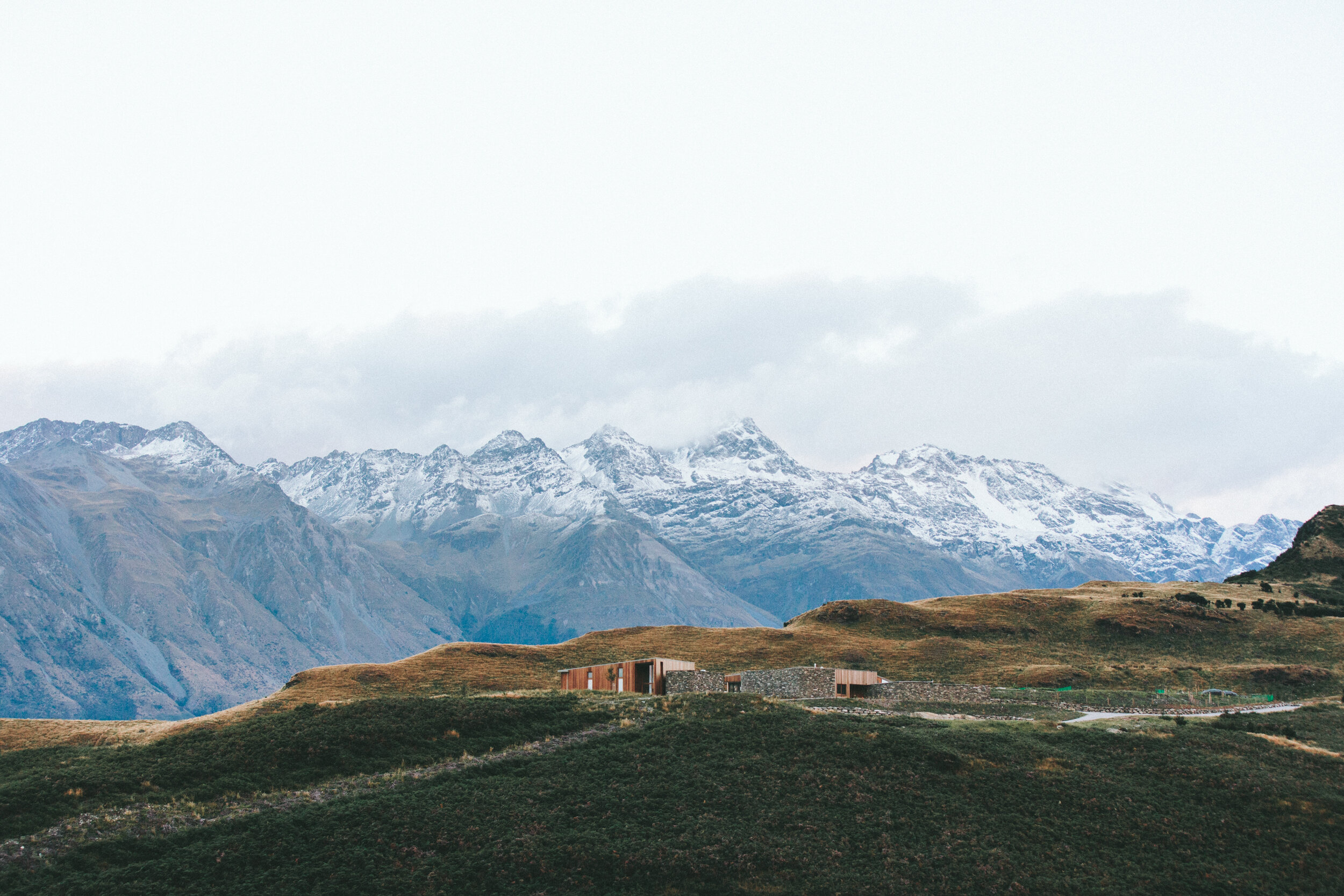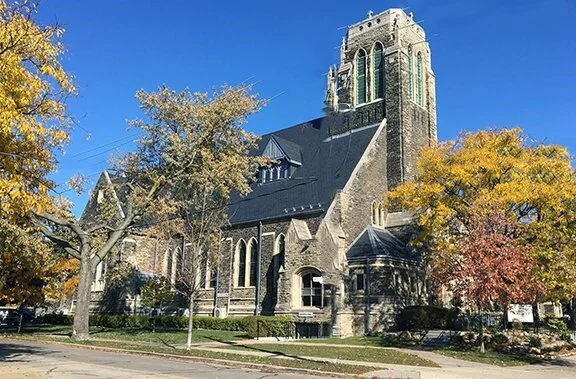Learn what is Possible
Explore some detailed stories of local projects below. For an overview and listing of the different initiatives be sure to visit our ‘Be Inspired’ page.
Laidlaw United Church, Hamilton
Lowering Operating Costs
“We didn’t start off trying to be green. We started off with a budget deficit. “
They first invested a little over a hundred dollars in a programmable thermostat which saved them $1000 in the first year.
Turning off the pilot lights on the big kitchen stove until someone needed to use the stove saved $250 in gas each year, and now the water heater is turned down for the summer, and they are changing the furnace filters regularly to make the furnaces run more efficiently. Replacing light bulbs with LED bulbs saved $50 a month on the hydro bill. They started asking about how to cut down on photo copies and paper. The cleaning crew started using fewer chemicals, and more elbow grease. They banned toilet pucks when a toilet puck caught in the flapper valve, increasing the water usage substantially until it was found. To improve heat in the gym, they moved the heat ducts from the ceiling to the floor, setting up a convection current, which made the gym warmer and used less fuel.
Then the roof needed replacing. They were concerned about both the cost and the waste that would end up in landfill. Their solution was to purchase a metal roof. That way, the old asphalt can stay right where it is, adding a bit of insulation instead of a ton of landfill. The steel will last 70 or more years, and then be completely recyclable at the end of its life. They added a peak to the old flat roof so it too could be covered with steel, eliminating the need to re-surface the asphalt every ten years. The contractor found a way to reline the gutters with steel instead of replacing, preserving them for another hundred years. Going green saved a lot of money—over the life of the new roof; they estimate they will save at least three replacements of those asphalt shingles, saving future generations about $130,000 over the next 70 years.
But with finances tight, they worried how to pay for it. The answer came in with the solar microFit program offered by the government. Installing 10kW of solar panels provided an income of about $9,500 each year, enough to pay the loan for the roof and solar panels.
All this takes organization but they were motivated to save money. They still do not have a formal “green team”, but have found that working together brings them closer as a community.
Holy Family Roman Catholic Church
Small actions build momentum
The Social Justice Committee at Holy Family has spearheaded some environmentally friendly initiatives over the years such as:
purchasing fair-trade coffee
eliminating the use of water bottles, styrofoam plates and cups etc at social gatherings
hosted climate change education sessions
produced a lenten calendar with suggestions for individual actions people could take during lent
ran a 6-part series on Laudato Si and plan to use that as a spring-board to look at things the parish could do to combat climate change.
Richards Memorial United Church
Solar
Richards Memorial decided to take advantage of the microfit solar program in 2019. They paid $87,000 for their solar panels through a loan from Presbytery and paid it back in 8 years with the profit from the panels.
Although they have a 20 year contract that guarantees a higher rate of return than you would get today, the purchase price for panels todays is much less.
St. Paul’s United Church, Petrolia
Reducing Operating Costs
Additional attic insulation, boiler room piping, Wi-Fi programmable thermostats and other investments make the 1899-constructed building more energy efficient. Improvements were completed in 2020 with $30,000 in grant money via the United Church of Canada’s Faithful Footprints program, property committee chairperson Larry Leckie said. De-stratification fans are next on the list of improvements to increase comfort and decrease costs.
“For example, we had a quote for sealing and caulking basement windows – we have 38 windows in the church. We got a quote for doing that for over $5,000,” he said. “We did it ourselves and the program put in $10,000 for us.”
The roughly 200-strong church membership also held fundraisers to bring in some of the $15,000 local investment, he said.
St. Michael’s Roman Catholic Church
Education
St. Michaels parish has been busy hosting climate talks, working on food security through the London Food Coalition and their school’s breakfast program.
Presentations on plant-based eating
Article in the quarterly parish newsletter about Laudato Si
St. Michael's recently installed a more energy efficient HVAC system which is 'on' only when the public is in the space. The parish participates in metal and paper recycling, and staff are mindful of minimizing energy and water consumption.
Future presentations are planned on Best Ecological Practices around food: food rescue, food waste and how our dietary choices impact our carbon footprint.
Anglican Church of the Incarnation, Oakville
Going Geothermal
Motivated by the desire to stop burning fossil fuels, they started looking at implementing a geothermal system. It would cost an additional one-third of the price of a traditional HVAC system; it was an unknown technology to most of the congregation; and no one was sure if the changes were worth the large price tag. It was a risky proposition resulting in a two-year long debate about cost and understanding the technology and eventually installed in 2019 for $316,518.
First-St. Andrew’s United Church
Leadership
First-St. Andrew’s United Church has a long history of environmental action.
hosted “Awakening the Dreamer” a 3 day Environmental Awareness course
hosted an Environment Week education program culminating in a trade show showcasing local “green” vendors
held a native plant sale, 2010
installed a bike rack, 2010
participated in Interfaith tree planting (ReForest London), 2013
planted a pollinator garden in 2018
converted outdoor lighting to LED bulbs - a $9,000 project with a 5 year ROI for energy savings, a substantial improvement in the quality of light delivered, and no re-lamping expense for up to 10 years
originating organization behind Climate Action London and continues to support the group by providing grant administration services
Urban Agriculture
A few years ago, Siloam United Church had a small 15’ x 20’ garden, growing food to donate to the London Food Bank. Then after a key staff person left, it lay fallow for a few years.
In 2019, when Pillar recognized Urban Roots for their innovative social enterprise, Urban Roots was vocal about finding more urban land to expand. Siloam answered that call. Siloam was well positioned: they had land, they had some history of gardening, and they had farmers in their congregation. But they instinctively knew they could not do this on their own. Partnering with Urban Roots has made all the difference.
Their city councillor, Maureen Cassidy became their champion at city hall, and helped them navigate re-zoning approval, and approval from the forestry department for the removal of some of the trees and shrubs that had taken root in this unused plot of land.
Siloam was granted 2 summer students to work the farm for the summer, and the United Church provided a grant to top up their wages from minimum wage to a living wage. Siloam donated about $3,000 and Urban Roots donated some funds, plants and expertise. Volunteers from the church and the community helped to clear and prepare the field. Now their 80’ x 100’ garden is thriving. Plans are underway to plant an orchard along the driveway to replace some of the trees cut down to clear the field. The vision continues to expand.
At the November 2021 monthly GSS-London meeting, Siloam United and Urban Roots discuss the challenges, details and unexpected benefits from this project. Watch here
St. Joseph Ecology and Spirituality Centre, Cobourg
Building Audits
One community that has participated in Faith and the Common Good’s Green Audit is the Villa St. Joseph Ecology & Spirituality Centre in Cobourg, Ontario.
This historic building on the shores of Lake Ontario is owned by the Congregation of the Sisters of St. Joseph in Canada. They had started with some small changes like switching to beeswax and battery-powered candles and only used biodegradable cleaning products.
They experienced that Building Standards change over time and there are now more defined Green Standards. 20 years ago, their attic insulation was deemed acceptable, but now they were encouraged to upgrade. As well, hot water pipes & water heaters were checked.
As a result, they purchased insulating “blankies” for the four hot water tanks, insulated the hot water pipes and increased the insulation batts in the attic.
Holy Trinity Anglican Church, Thornhill
Taking it slow
Work to date has consisted of low hanging fruit. Measures include programmable thermostats; (locked and adjusted by HTC staff); upgrading LED light bulbs; fan covers in the balcony rooms (no one knew these legacy openings existed before the audit).
Holy Trinity joined Faith & the Common Good’s benchmarking program in February, 2018. We hope that by benchmarking our building's performance, we will learn best practices and share these with other congregations. HTC has developed a ten-year plan whereby the very expensive items will be addressed and rectified. The team meets at least quarterly to review all initiatives and update the congregation, as needed.
Energy Conservation
We have hosted two Faith & the Common Good (FCG) energy conservation and energy efficiency workshops, and have been a role model for other Catholic parishes in Toronto. We were the first faith community to sign up for the FCG energy benchmarking program, and volunteered to be a “guinea pig”, while FCG “ironed out” the logistics of the program. As a result of this, other Catholic parishes have participated in the energy benchmarking program, and have also engaged in energy conservation and energy efficiency retrofits, at their respective buildings.
In 2016, we installed programmable thermostats, which helped reduce our gas consumption by 23% in 2016 (versus 2015). We believe that our gas consumption increased by 7% in 2017 (versus 2016), due to increased occupancy in our Church Hall. This is very good news, as we have been able to increase our rental income. We were pleased to see that our hydro consumption decreased by 7% in 2017 (versus 2016); we attribute this to the fact that we did an LED lighting retrofit in our Church Hall and Sanctuary in 2017 Read More
St. Brigid’s Parish, Toronto
Quaker House, Hamilton
Energy Efficient Retrofits
The first major energy retrofit was to add a cladding around their building in 2010, it was a layer that provided more insulation for the building.
In 2016, the windows were replaced with more energy efficient ones. Condensation was building up and the plastic was breaking down making them harder to open. Shortly after, in 2018, the furnace needed to be replaced as it was no longer operational.
Both these retrofits came out of necessity as well as needing the upgrades. Both were replaced with more energy efficient successors.
In the summer of 2018, the roof was replaced with a new steel roof. A steel roof would last longer with a life expectancy of 50-75 years versus 15-25 years for a shingled roof. As well, they reflect heat lowering cooling costs. Lastly, at the end of their life cycle, steel roofs are recyclable.
Climate Change and the Vatican
-

Young Activist Helping Pope Francis Battle Climate Change
Written for New Yorker magazine by David Owen, February 1, 2021
While attending Canisius College, in Buffalo, Molly Burhans spent a week on a service retreat at a monastery in northwestern Pennsylvania, and she was struck that the resident Sisters were doing almost nothing with their property other than mowing its immense lawn. “There were many acres of forest, but, at that time, there was no forest plan, no erosion plan, no invasive-species plan,” she said. “And I thought, Wow, this could be done better. They could be doing sustainable forest management and earning revenue, or they could implement a permaculture farming system and actually feed people.”
Burhans was in graduate school, studying landscape design, at the time Laudato Si was released She described “Laudato Si’ ” as “one of the most important documents of the century,” but she also said that, not long after Francis presented it, she discovered that the Church had no real mechanism for achieving its goals. “The Catholic Church is the world’s largest non-government provider of health care, humanitarian aid, and education,” she said, “and I assumed that it must have a significant environmental network, too.” She identified a number of ecology-focussed Catholic groups, mostly in wealthier parishes, but no central organization that she could join—no Catholic Sierra Club or Nature Conservancy, no environmental equivalent of Catholic Relief Services.
In September of 2015 she founded GoodLands, an organization whose mission, according to its Web site, is “mobilizing the Catholic Church to use her land for good.”
Burhans’s immediate goal was to use technology that she had become proficient at in graduate school, geographic information systems (G.I.S.) to create a land-classification plan that could be used in evaluating and then managing the Church’s global property holdings.
The first step was to document the Church’s actual possessions. She began by making telephone calls to individual parishes in Connecticut, where she lived. “And what I found out was that none of them knew what they owned,” she told me. “Some of them didn’t even have paper records.” She enlisted volunteers, including several graduate students at the Yale School of the Environment, and, by harvesting data from public land records and other sources, they began to assemble a map of the modern Catholic realm. By June of 2016, the most detailed reference they’d found was a version of “Atlas Hierarchicus,” published at the behest of the Vatican. The maps in it had last been updated in 1901. “The diocesan boundaries in the atlas were hand-drawn, without a standardized geographic projection,” and the information was so outdated that most of it was unusable. When she travelled to Rome that summer, her main goal was to find someone in the Vatican who could give her access to the Holy See’s records and digital databases, enabling her to fill in the many gaps.
At the end of her meeting with the priests, Burhans asked whether they would mind if she continued to gather information on her own, since they didn’t have what she was looking for. In the end, they said, ‘Yes, that would be useful for everything.’ ” She thanked them, and told them that she would be back.
-

Vatican reveals vast real estate holdings
Vatican released information on its real estate holdings for the first time on Saturday, revealing it owns more than 5,000 properties as part of its most detailed financial disclosures ever. The 30 page report titled the Administration of the Patrimony of the Holy See (APSA) showed that it owns 4,051 properties in Italy and about 1,120 abroad.
About 40% of properties were institutional buildings such as schools, convents and hospitals.
Read full Globe and Mail article here
The Church, furthermore, is probably the world’s largest non-state landowner. The assets of the Holy See, combined with those of parishes, dioceses, and religious orders, include not just cathedrals, convents, and Michelangelo’s Pietà but also farms, forests, and, by some estimates, nearly two hundred million acres of land.

















